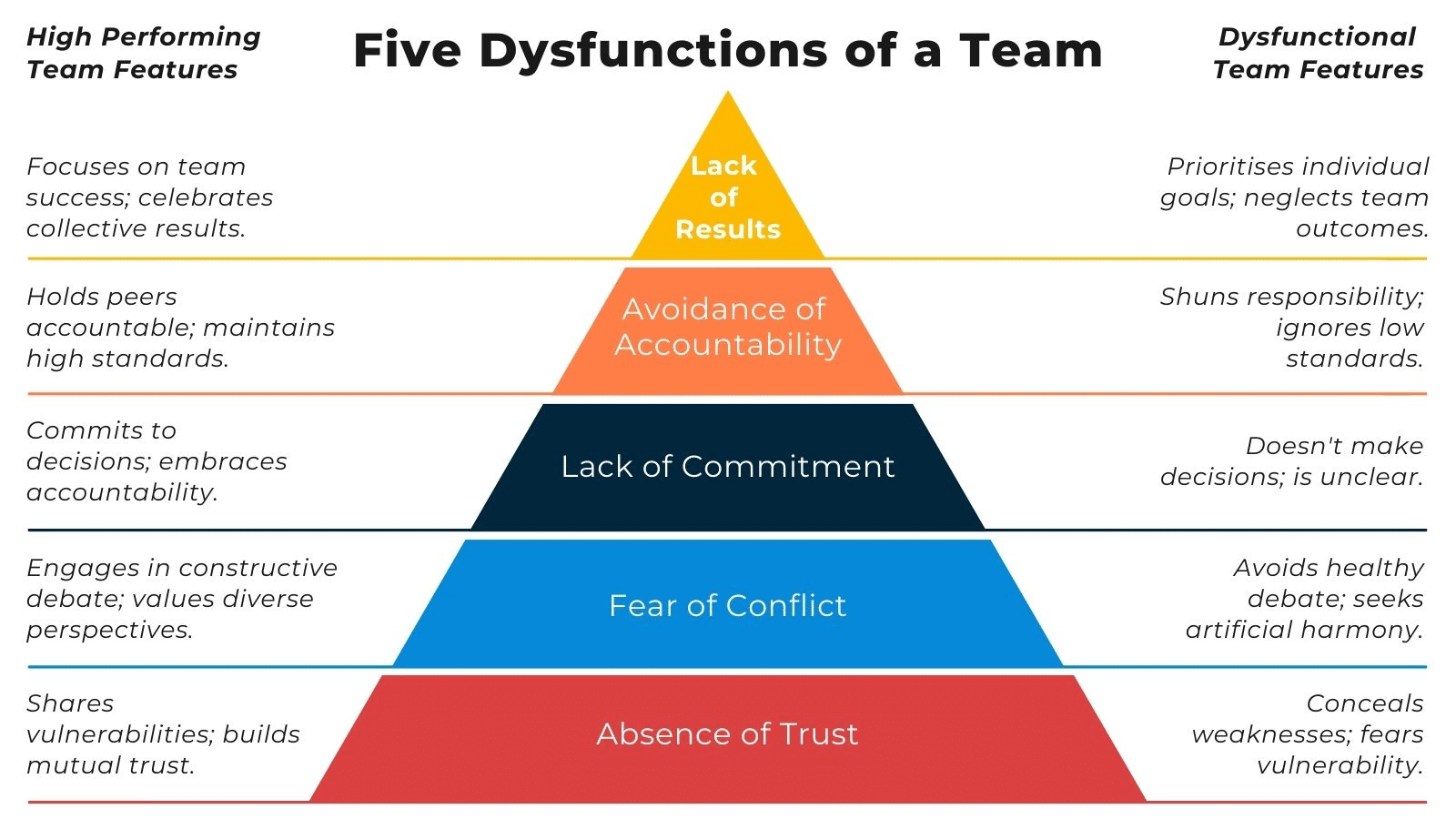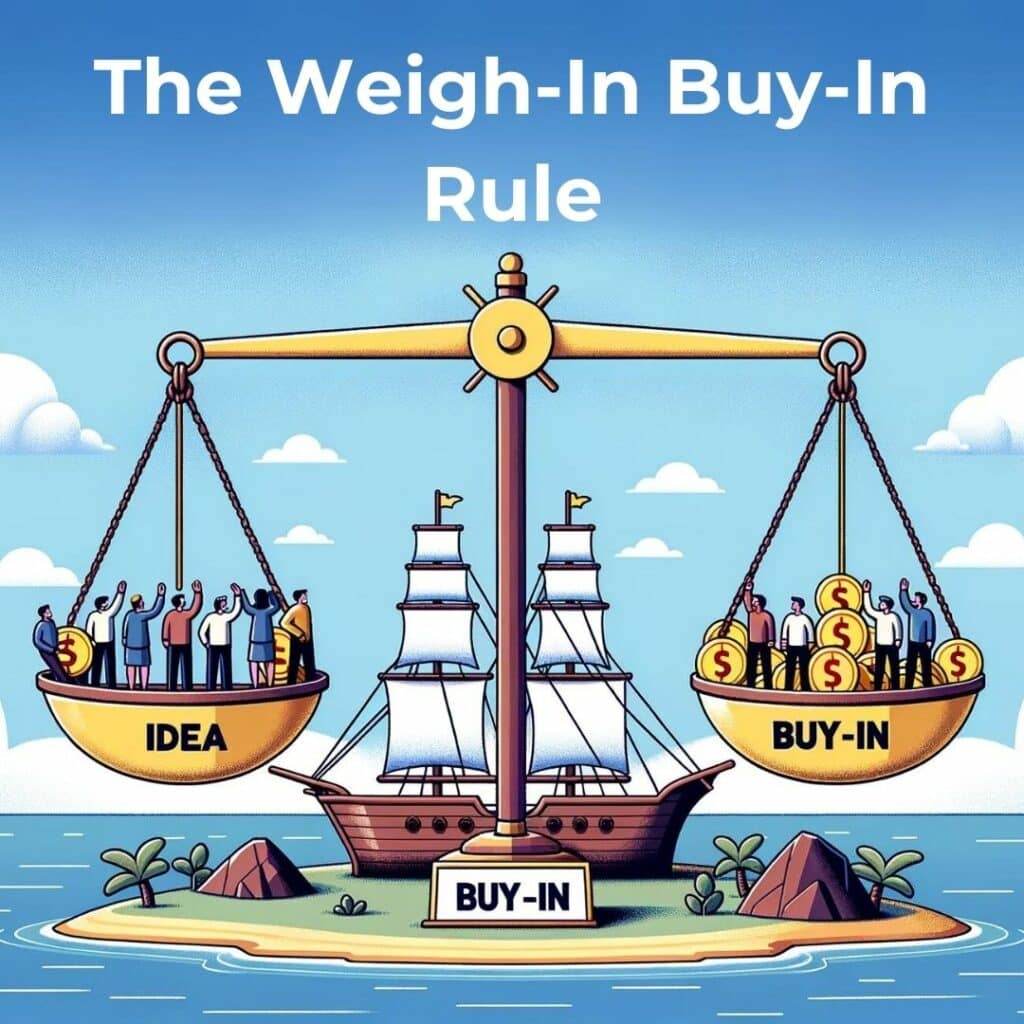Are the 5 dysfunctions of a team something you need to tackle?
Maybe you’ve been part of a group of talented people that never seemed to reach its potential. Or perhaps you’ve been in a team where everyone has a strong opinion but always failed to reach a consensus. Conversely, you may have been part of a less talented unit that unexpectedly achieved great things.
Behind these team conundrums often lie hidden dysfunctions or a lack thereof. They’re subtle and often insidious, and if left unaddressed, they can take a massive toll on productivity and morale.
The Five Dysfunctions of a Team Book
Patrick Lencioni, founder of Table Group, a management consulting firm, introduced the concept of team dysfunctions in his book, “The Five Dysfunctions of a Team: A Leadership Fable”.
Lencioni’s book comprehensively explains the underlying dysfunctions that prevent a team from reaching its full potential. This book is a treasure trove of insights into team dynamics, offering practical strategies to address and overcome these dysfunctions.
Lencioni presents these complex concepts in an engaging and accessible manner, making it a must-read for anyone seeking to improve their team’s performance and success.
With Patrick Lencioni’s “5 Dysfunctions of a Team” as our compass, let’s navigate these treacherous waters and explore the depths of team performance. Let’s dive into team dysfunctions, discuss their impact, and explore practical strategies to overcome them.
By understanding and addressing these dysfunctions, you can empower your team, taking them from the murky depths of dysfunction to reach new heights of success.
Key Takeaways
-
Lencioni’s Five Dysfunctions model highlights challenges in team dynamics and group performance.
-
There are many strategies you can use to address these dysfunctions.
-
Addressing the dysfunctions can dramatically improve team performance, trust and overall wellbeing.
-
Lencioni’s model provides you with a roadmap to transforming your team’s interactions and achieving superior performance.
What are the 5 Dysfunctions of a Team?
The ‘5 Dysfunctions of a Team’ is a team dynamics model presented by Patrick Lencioni in his book titled “The Five Dysfunctions of a Team.”
His model identifies five key dysfunctions, which he illustrates in a pyramid, that can hinder a team’s performance; they are:
-
Absence of Trust: This is the foundation of the pyramid of dysfunctions. In this context, trust is the ability of team members to show vulnerability among their peers, admitting mistakes, weaknesses, or lack of knowledge. Without this trust, the other dysfunctions become more prevalent.
-
Fear of Conflict: Teams that lack trust often cannot have productive, passionate debates or disagreements about issues. Instead, they engage in veiled discussions and guarded comments, which avoid a meaningful resolution.
-
Lack of Commitment: Without hashing out disagreements and voicing opinions, team members will rarely commit to decisions. This dysfunction leads to ambiguity among the team about direction and priorities.
-
Avoidance of Accountability: If a team doesn’t commit to a clear action plan, even the most focused and driven individuals hesitate to call out their peers on counterproductive behaviours.
-
Inattention to Results: When team members aren’t held accountable, they often put their personal status, ego, or career advancement ahead of the collective results of the team. This dysfunction is often a result of the prior dysfunctions taking hold.
The Impact of Team Dysfunctions and Fixing Them
Each of these dysfunctions has the ability to wreak havoc in a team, significantly impacting its members’ ability to work together effectively and achieve their goals. Regardless of the skill or experience, the more dysfunctions present, the less likely a team is to perform.
Luckily, Lencioni posits that if a team acknowledges and addresses the dysfunctions head-on, they can improve their performance. The benefits of that should be pretty clear, but I think Lencioni says it best with this quote:
“If you could get all the people in an organization rowing in the same direction, you could dominate any industry, in any market, against any competition, at any time.”
― Patrick Lencioni, The Five Dysfunctions of a Team: A Leadership Fable
The 5 Dysfunctions Pyramid

Lencioni’s five dysfunctions Pyramid visually represents the hierarchical structure the model conforms to, with trust as the foundation.
Accordingly, trust is the cornerstone of a successful and healthy team; it enables team members to engage in open and honest communication, which is essential for fostering healthy conflict, commitment, and accountability.
Each subsequent dysfunction builds upon the previous one, ultimately culminating in a team inattentive to results.
So, on to a more detailed look at dysfunction one, ‘the absence of trust’.
Dysfunction 1: Absence of Trust – The Foundation of Dysfunction
Sitting at the bottom of the pyramid, Trust is the bedrock of a high-performing team. When trust is absent, members are more likely to conceal weaknesses and mistakes, be hesitant to ask for assistance and make assumptions about the perceived negative intentions of others.
In its most destructive form, a lack of trust can make team members fear that others will use their admissions against them or view them as less competent. As a result, they might choose not to ask for help even when needed, which can hinder individual and team performance.
Perhaps more worryingly, people who lack trust conceal weaknesses, which can prove truly dangerous in some situations!
A lack of trust can lead to a toxic work environment where team members prioritise personal status over progress toward collective goals. This diminishes the team’s combined success.
“Remember teamwork begins by building trust. And the only way to do that is to overcome our need for invulnerability.”
― Patrick Lencioni
Overcoming the first dysfunction and paving the way for addressing the remaining dysfunctions is achievable by fostering an atmosphere of trust.
⇓ Click here to discover strategies for overcoming the absence of trust.
Dysfunction 2: Fear of Conflict – Hindering Productive Discussions
Healthy conflict is crucial for a team’s success, as it fosters productive discussions, improves decision-making, and ensures that team members are held accountable for their actions.
However, when teams are plagued by fear of conflict, they avoid addressing pressing issues and engaging in passionate debates.
This desire to prioritise artificial harmony significantly impacts teams: critical topics remain unaddressed, innovation is stifled, and resentment and tension quietly build.
The result is that decision-making is hindered, and the team’s ability to adapt and grow is compromised, preventing the realisation of its full potential.
⇓ Click here to discover strategies for overcoming the fear of conflict.
Dysfunction 3: Lack of Commitment – The Detachment Dilemma
A team’s success is contingent upon the commitment of its members to the team’s goals and decisions. When team members lack commitment, they may become detached and unproductive, leading to a decline in team performance.
According to Lencioni, the two most significant impediments to commitment are consensus and the requirement for certainty. That means that a lack of commitment in teams arises when there’s ambiguity around decisions and direction.
Typically stemming from a lack of clarity or buy-in, it can lead to an environment where team members are hesitant or resistant to embrace and support the agreed-upon direction or decisions fully.
The impact of this dysfunction on teams is profound. Without solid commitment, teams often experience missed opportunities, inconsistent execution, and a lack of alignment in actions and efforts, ultimately hampering the team’s overall success and momentum.
⇓ Click here to discover strategies for overcoming the lack of commitment.
Dysfunction 4: Avoidance of Accountability – The Downfall of Standards
Accountability is a critical component of a high-performing team. EXAMPLE
The need for team members to avoid interpersonal discomfort makes them reluctant to address their peers’ actions and behaviours that could be detrimental to the team.
Unfortunately, this lack of accountability can lead to a decline in standards, poor performance, and an overall deterioration of the team’s success.
⇓ Click here to discover strategies for overcoming the avoidance of accountability.
Dysfunction 5: Inattention to Results – Personal vs. Collective Success
The ultimate dysfunction, inattention to results, manifests when team members place their personal goals and achievements above the team’s collective success.
The impact on teams is significant: efforts become fragmented, team cohesion deteriorates, and overall performance drops.
Instead of rallying together for shared success, members may become more self-oriented, leading to a diluted sense of purpose and missed opportunities for the team as a whole.
⇓ Click here to discover strategies for overcoming the inattention to results.
How to overcome the 5 dysfunctions of a team
Addressing and overcoming each of the five dysfunctions is a crucial step toward improving team performance and success. By tackling each dysfunction one at a time, teams can:
The following sections will provide practical strategies for overcoming each dysfunction, empowering your team to perform at its best and achieve its goals.
1. Building Trust: Overcoming the First Dysfunction
Actively fostering trust is essential to overcome the first dysfunction, the absence of trust.
Trust-building exercises, such as those focusing on understanding and appreciating your colleagues’ behavioural preferences, can help develop stronger relationships and improve teamwork.
An absence of trust exercise you can use: A favourite of mine
An exercise promoted in Lencioni’s book is the personal histories activity. The activity encourages team members to share the ‘non-controversial’ parts of their backgrounds and formative experiences with the group.
In short, they do this exercise to build understanding and empathy.
By understanding where each team member comes from and what has shaped them, individuals can better appreciate their colleagues’ perspectives and behaviours. This all contributes to the team’s diversity and strength.
The personal histories activity is one of the many practical exercises Lencioni suggests for building trust within a team. It has worked for my teams on many occasions.
-
Team Effectiveness Exercise: This exercise involves members identifying what each person does that is most beneficial to the group. Conversely, they must identify behaviours that they see as detrimental. This should be done in a positive, constructive environment to help colleagues give and receive feedback.
-
Personality and Behavioural Preference Profiles: Tools like the Myers-Briggs Type Indicator (MBTI), Belbin’s Team Roles and others can be used. These assessments help each person understand their own personalities and those of their colleagues. By understanding individual tendencies and preferences, teams can work more harmoniously and anticipate potential sources of conflict.
-
360-Degree Feedback: This is a more in-depth form of assessment where all parties receive anonymous feedback from their peers. This process can help identify areas where an individual may be unknowingly causing distrust.
-
Regular Team Building: Organise regular team-building activities and offsites to nurture trust. Don’t worry. This doesn’t have to be one of those stereotypical ‘trust fall’ exercises! Any activity will do if it gets the group interacting in different ways outside of their regular work environment.
Build trust as a leader
To build trust, you must encourage team members to be more open, but don’t forget the role played by the team leader. Leaders must model trust in themselves and demonstrate vulnerability and openness to create an atmosphere where members feel comfortable sharing their thoughts and ideas.
Working on your emotional intelligence skills is a great place to start as a leader. Your ability in this area will help you excel in building trust with your team.
Take our free emotional intelligence test today and get a detailed report with targeted tips and techniques to skyrocket your EQ.

Lencioni emphasises that trust-building is an ongoing process. It requires regular attention and effort, especially as teams change and grow. The foundation of trust then paves the way for addressing the other four dysfunctions he identifies.
2. Embracing Healthy Conflict: Tackling the Second Dysfunction

To tackle the second dysfunction, fear of conflict, teams must establish trust. They must also create an environment where members feel comfortable expressing their opinions and ideas.
Once trust is established, members feel safe engaging in productive conflict. That means they express differing opinions, disagree, and engage in passionate debate, knowing they won’t face personal attacks.
To foster healthy conflict, Lencioni emphasises behaviours and practices you should encourage:
-
Mining for Conflict: Leaders and facilitators should seek out disagreements lurking passively in the team. Once found, they should bring them to the surface for resolution. You could call this ‘fostering honest debate’. This process ensures that unresolved issues are not left to fester.
-
Real-time Permission: When a member is holding back during meetings or discussions, give them real-time permission to disagree. It can be as straightforward as asking, “Do you seem to disagree with that point? Please share your thoughts.”
-
Clarify Acceptable Behaviour: Establish clear guidelines for what constitutes an acceptable level of conflict. This might mean focusing on ideas (not personal attacks), listening actively, or seeking first to understand before responding.
-
Post-Conflict Follow-Up: If a particularly intense disagreement occurs, it’s beneficial for the involved parties to connect afterwards to ensure no lingering negative feelings. This can be a simple check-in or a more formal debrief.
-
Regular Reviews: Periodically review and discuss the team’s behavioural dynamics. Assess how they are handling conflicts and address any recurring issues or patterns.
Leaders Role Model Healthy Conflict
Leaders should model appropriate conflict behaviour. When people see leaders engaging in constructive conflict and passionate debate focused on ideas (not personalities), they’ll recognise it as acceptable and beneficial.
As a leader, your job is to cultivate an environment and atmosphere that celebrates healthy conflict. When you do your teams can overcome this dysfunction and move on to tackling a lack of commitment.
3. Strengthening Commitment: Addressing the Third Dysfunction

To address the third dysfunction, lack of commitment, leaders must ensure that all team members fully commit to the team’s goals and objectives. Leaders can create an environment where members feel comfortable expressing their perspectives and concerns, ultimately leading to greater commitment by fostering trust and promoting healthy conflict.
Team commitment is like glue – it bonds the members together and helps to hold everyone accountable. Without it, things fall apart like a house of cards!
When teams don’t commit to decisions, it usually stems from a lack of clarity or buy-in. Lencioni suggests several tactics and exercises to tackle this dysfunction:
-
Cascading Messaging: Once a decision is made in a team meeting, it should be quickly communicated to get all parties on the same page. This ensures everyone has clarity on what’s been decided and can commit to the direction set.
-
Deadlines for Decisions: Set specific timelines for when decisions will be made. This creates a sense of urgency and prevents indecision from dragging on indefinitely.
-
Contingency and Worst-Case Scenario Analysis: Have the team discuss what would happen if the decision turns out to be wrong. This helps members become comfortable with the idea that they can adapt and correct course if necessary.
-
Use of Clear Objectives and Standard Operating Procedures: Clearly outline the main objectives and any standard procedures to ensure everyone knows what they’re working toward and how.
-
Commitment Clarification: At the end of team discussions and meetings, it’s useful to have a specific moment where the group openly agrees on what has been decided, ensuring no ambiguity.
The “Weigh-in Buy-in” rule (My Favourite)

The “Weigh-in Buy-in” rule emphasises that people need to weigh in on a decision before they can truly buy into it. The essence of this principle is that individuals are more likely to commit to a decision (even when they initially disagreed) if they had the opportunity to provide input during the decision-making process.
The underlying principle for tackling a lack of commitment is ensuring clarity and achieving buy-in. So, even if team members disagree with a decision, everyone must support it once a decision is made.
Lencioni reasons that members can commit to decisions when there’s trust in a team. That’s because they’ve been heard and know the team is collectively moving in the best direction for the organisation.
With a tick in the commitment box, it’s time for the team to get accountable!
4. Enhancing Accountability: Conquering the Fourth Dysfunction
To conquer the fourth of the five dysfunctions of a team, avoidance of accountability, leaders must establish clear expectations and maintain consistency.
Lencioni emphasises that peers, not just leaders or managers, should hold one another accountable to uphold standards and deliver results.
To address the avoidance of accountability within teams, he suggests several approaches and exercises:
-
Clear Commitments: At the end of meetings, review and clarify the commitments each team member is making. This sets clear expectations and provides a basis for peers to hold each other accountable.
-
Regular Progress Reviews: Hold regular check-ins or review meetings to assess progress toward commitments. This helps ensure that issues or deviations are addressed promptly.
-
Team Effectiveness Exercises: Ask team members to provide feedback on their peers’ performance. You can do this in a structured format, like a 360-degree feedback process, or a more casual manner, such as during a team meeting. The latter definitely relies on the foundation of trust!
-
Clarification of Team Goals and Standards: Ensure clear objectives, roles, and responsibilities. When larger goals are understood, and people get their part in achieving them, it becomes easier to hold each other accountable.
-
Consequences for Not Delivering: Establish clear consequences for failing to deliver on commitments. This doesn’t necessarily mean punitive measures but could involve revisiting goals, adjusting resources, or providing additional support where needed.
Leaders Role Model Accountability
Leaders and managers should set the tone by holding themselves accountable and addressing issues promptly. When team members see their leaders taking accountability seriously, they’re more likely to do the same.
By implementing these exercises and fostering a culture of accountability, teams can ensure members are invested in the team’s outcomes, deliver on their commitments, and address issues constructively and proactively.
With four dysfunctions down, it’s time to address the pyramid’s pinnacle, inattention to results.
5. Prioritising Team Results: Defeating the Fifth Dysfunction

To defeat the fifth dysfunction, inattention to results, leaders must emphasise the importance of prioritising team results over individual achievements.
There are several strategies and exercises you can use to drive attention to results; here are some:
-
Regularly Review Goals and Progress: Dedicate a portion of meetings to reviewing performance metrics, progress towards goals, and milestones. This keeps the focus on results and helps the crew to change course when needed.
-
Use Team Rewards and Celebrate Collective Wins: Instead of rewarding individual achievements, structure compensation, recognition and celebration around the unit’s success. This fosters a sense of collective responsibility for results.
-
Use Scoreboards or Progress Boards: Visual aids can be powerful tools to keep everyone aligned. A clear, visual representation of progress toward the team’s goals can motivate and highlight areas that need attention.
-
Shift Focus from Status and Ego to Results: This may involve group discussions to explore why a team member prioritises personal recognition over group success. Once these issues are in the open, you can address them directly.
-
Post-Mortem Reviews: After a project or quarter, conduct a review to discuss what went well and what didn’t. This exercise, often referred to as a retrospective, ensures that the group learns from its experiences and focuses on improving results.
By implementing these exercises and strategies, teams can work toward a culture where results are prioritised, and individual agendas or egos take a backseat to collaborative success.
5 Dysfunctions of a Team Summary
Team dynamics play a pivotal role in the success of any organisation. The intricacies of how members interact, trust, communicate, and work towards a collective goal can make or break any ‘collaboration’.
As we’ve delved deep into the dysfunctions, it’s evident that addressing them systematically transforms the fabric of group interactions and paves the way for unprecedented success.
Trust, open communication, accountability, and a shared vision are not just buzzwords; they are the lifeline of a high-performing team.
Whether you’re a leader at a startup, a manager at a multinational company, or someone aspiring to be a part of a cohesive team, embracing the Lencioni Model tailored to your unique needs can be the game-changer.
As a leader, you must learn to recognise and address your weaknesses to support your team.
So, as you move forward, remember that fostering a harmonious team environment is an ongoing process that offers invaluable rewards. Here’s to building teams that function efficiently and thrive together!
My Experience with the Five Dysfunctions
To close, let me tell you that this is one of the best and most impactful books I have read in the realm of team leadership. I have used Lencioni’s model with several teams on my leadership journey, and the results have always been significantly positive.
The model’s effectiveness in identifying and addressing team dysfunctions is truly remarkable. It provides a clear roadmap to better group dynamics, improved communication, and superior performance.
By focusing on each dysfunction, bottom-up and one at a time, you can guide your teams toward better performance, morale and cohesiveness.









